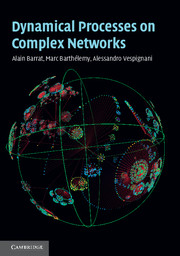Book contents
- Frontmatter
- Contents
- Preface
- Acknowledgements
- List of abbreviations
- 1 Preliminaries: networks and graphs
- 2 Networks and complexity
- 3 Network models
- 4 Introduction to dynamical processes: theory and simulation
- 5 Phase transitions on complex networks
- 6 Resilience and robustness of networks
- 7 Synchronization phenomena in networks
- 8 Walking and searching on networks
- 9 Epidemic spreading in population networks
- 10 Social networks and collective behavior
- 11 Traffic on complex networks
- 12 Networks in biology: from the cell to ecosystems
- 13 Postface: critically examining complex networks science
- Appendix 1 Random graphs
- Appendix 2 Generating functions formalism
- Appendix 3 Percolation in directed networks
- Appendix 4 Laplacian matrix of a graph
- Appendix 5 Return probability and spectral density
- References
- Index
12 - Networks in biology: from the cell to ecosystems
Published online by Cambridge University Press: 05 September 2012
- Frontmatter
- Contents
- Preface
- Acknowledgements
- List of abbreviations
- 1 Preliminaries: networks and graphs
- 2 Networks and complexity
- 3 Network models
- 4 Introduction to dynamical processes: theory and simulation
- 5 Phase transitions on complex networks
- 6 Resilience and robustness of networks
- 7 Synchronization phenomena in networks
- 8 Walking and searching on networks
- 9 Epidemic spreading in population networks
- 10 Social networks and collective behavior
- 11 Traffic on complex networks
- 12 Networks in biology: from the cell to ecosystems
- 13 Postface: critically examining complex networks science
- Appendix 1 Random graphs
- Appendix 2 Generating functions formalism
- Appendix 3 Percolation in directed networks
- Appendix 4 Laplacian matrix of a graph
- Appendix 5 Return probability and spectral density
- References
- Index
Summary
Networks have long been recognized as having a central role in biological sciences. They are the natural underlying structures for the description of a wide array of biological processes across scales varying from molecular processes to species interactions. Especially at smaller scales, most genes and proteins do not have a function on their own; rather they acquire a specific role through the complex web of interactions with other proteins and genes. In recent years this perspective, largely fostered by the recent abundance of high-throughput experiments and the availability of entire genome sequences and gene co-expression patterns, has led to a stream of activities focusing on the architecture of biological networks.
The abundance of large-scale data sets on biological networks has revealed that their topological properties in many cases depart considerably from the random homogeneous paradigm. This evidence has spurred intense research activity aimed at understanding the origin of these properties as well as their biological relevance. The problem amounts to linking structure and function, in most cases, by understanding the interplay of topology and dynamical processes defined on the network. Empirical observations of heterogeneities have also revamped several areas and landmark problems such as Boolean network models and the issue of stability and complexity in ecosystems.
While concepts and methods of complex network analysis are nowadays standard tools in network biology, it is clear that a discussion of their relevance and roles has to be critically examined by taking into account the specific nature of the biological problem.
- Type
- Chapter
- Information
- Dynamical Processes on Complex Networks , pp. 267 - 293Publisher: Cambridge University PressPrint publication year: 2008



